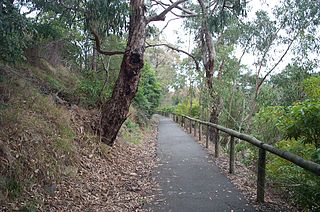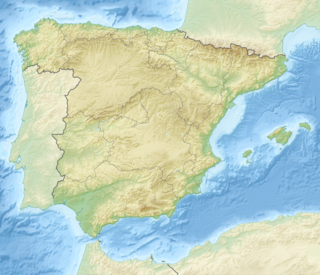
The Vía Verde de la Sierra is a rail trail for tourist use (hiking, cycling and horse riding) comprising 38 km (24 mi) of mountainous landscape between Puerto Serrano and Olvera villages, provinces of Cádiz and Sevilla. It is part of Vías Verdes of Spain (Spanish national rail trail system). [1]

A rail trail is the conversion of a disused railway track into a multi-use path, typically for walking, cycling and sometimes horse riding and snowmobiling. The characteristics of abandoned railways—flat, long, frequently running through historical areas—are appealing for various developments. The term sometimes also covers trails running alongside working railways; these are called "rails with trails". Some shared trails are segregated, with the segregation achieved with or without separation. Many rail trails are long-distance trails.

Hiking is the preferred term, in Canada and the United States, for a long, vigorous walk, usually on trails (footpaths), in the countryside, while the word walking is used for shorter, particularly urban walks. On the other hand, in the United Kingdom, and the Republic of Ireland, the word "walking" is acceptable to describe all forms of walking, whether it is a walk in the park or backpacking in the Alps. The word hiking is also often used in the UK, along with rambling, hillwalking, and fell walking. The term bushwalking is endemic to Australia, having been adopted by the Sydney Bush Walkers club in 1927. In New Zealand a long, vigorous walk or hike is called tramping. It is a popular activity with numerous hiking organizations worldwide, and studies suggest that all forms of walking have health benefits.

Cycling, also called biking or bicycling, is the use of bicycles for transport, recreation, exercise or sport. People engaged in cycling are referred to as "cyclists", "bikers", or less commonly, as "bicyclists". Apart from two-wheeled bicycles, "cycling" also includes the riding of unicycles, tricycles, quadracycles, recumbent and similar human-powered vehicles (HPVs).
Contents
The path goes along the riverside of Guadalete and Guadalporcún, around the nature reserve of Peñón de Zaframagón (where there is a large colony of griffon vultures) and the natural monument of Chaparro de la Vega.

The Guadalete River is located almost entirely in the Spanish province of Cádiz, rising in the Sierra de Grazalema Natural Park at an elevation of about 1,000 metres (3,300 ft), and running for 172 kilometres (107 mi) into the Bay of Cádiz at El Puerto de Santa Maria, south of the city of Cádiz. The river's name comes from the Arabic phrase meaning "River of Forgetfulness".

A nature reserve is a protected area of importance for flora, fauna or features of geological or other special interest, which is reserved and managed for conservation and to provide special opportunities for study or research. Nature reserves may be designated by government institutions in some countries, or by private landowners, such as charities and research institutions, regardless of nationality. Nature reserves fall into different IUCN categories depending on the level of protection afforded by local laws. Normally it is more strictly protected than a nature park.

The griffon vulture is a large Old World vulture in the bird of prey family Accipitridae. It is also known as the Eurasian griffon. It is not to be confused with a different species, Rüppell's griffon vulture. It is closely related to the white-backed vulture.
The route uses a rail track between Jerez de la Frontera (Cádiz) and Almargen (Málaga) through the Cádiz mountains.

Jerez de la Frontera, or simply Jerez, is a Spanish city and municipality in the province of Cádiz in the autonomous community of Andalusia, in southwestern Spain, located midway between the Atlantic Ocean and the Cádiz Mountains. As of 2015, the city, the largest in the province, had a population of 212,876. It is the fifth largest in Andalusia, and has become the transportation and communications hub of the province, surpassing even Cádiz, the provincial capital, in economic activity. Jerez de la Frontera is also, in terms of land area, the largest municipality in the province, and its sprawling outlying areas are a fertile zone for agriculture. There are also many cattle ranches and horse-breeding operations, as well as a world-renowned wine industry (Xerez).

Almargen is a town and municipality in the province of Málaga, part of the autonomous community of Andalusia in southern Spain. The municipality is situated approximately 105 kilometers from the capital, Málaga. It is 43.7 km from Ronda and 48.2 km from Antequera. It has a population of approximately 2,100 residents. The natives are called Almargeños.





















